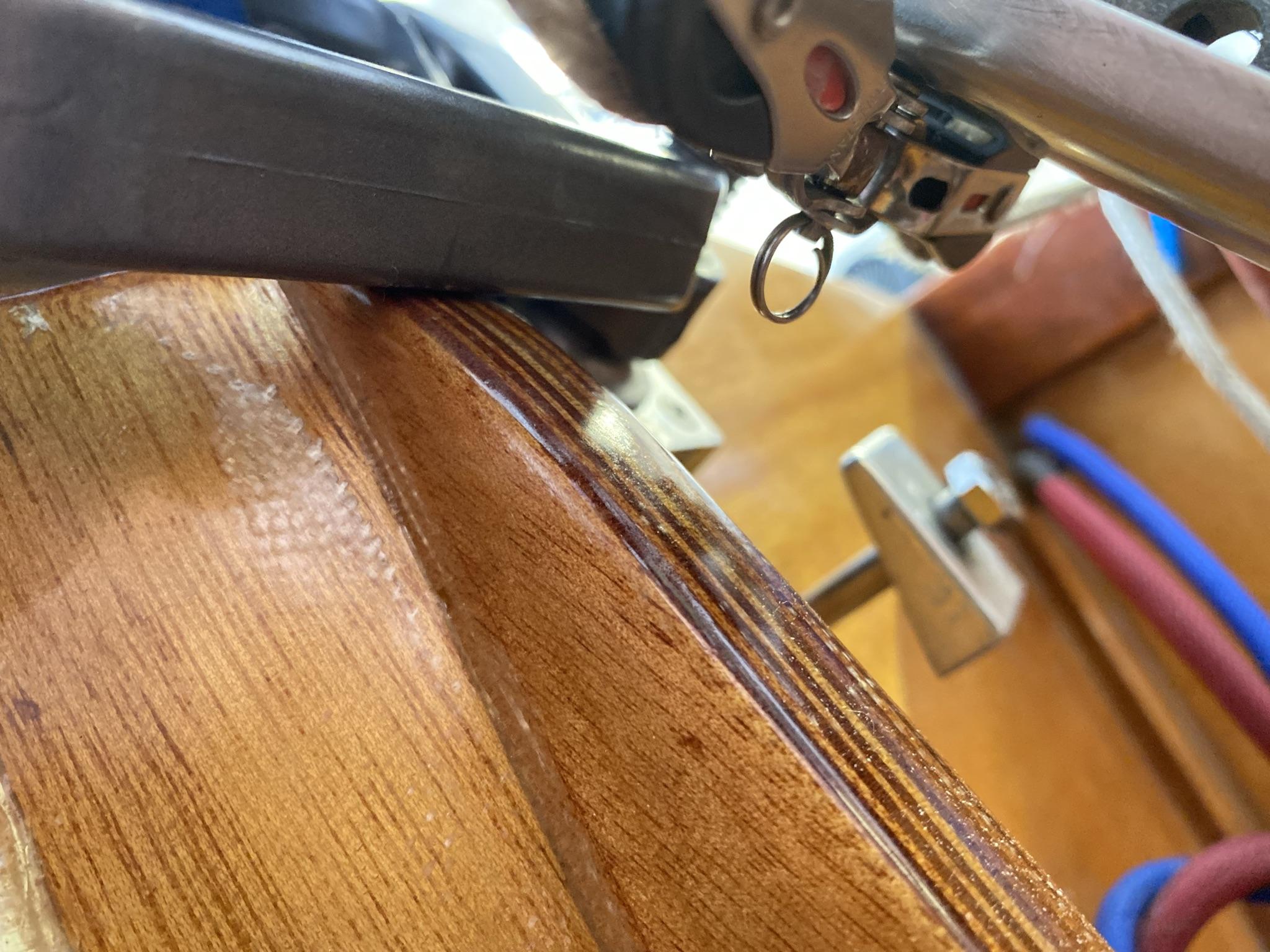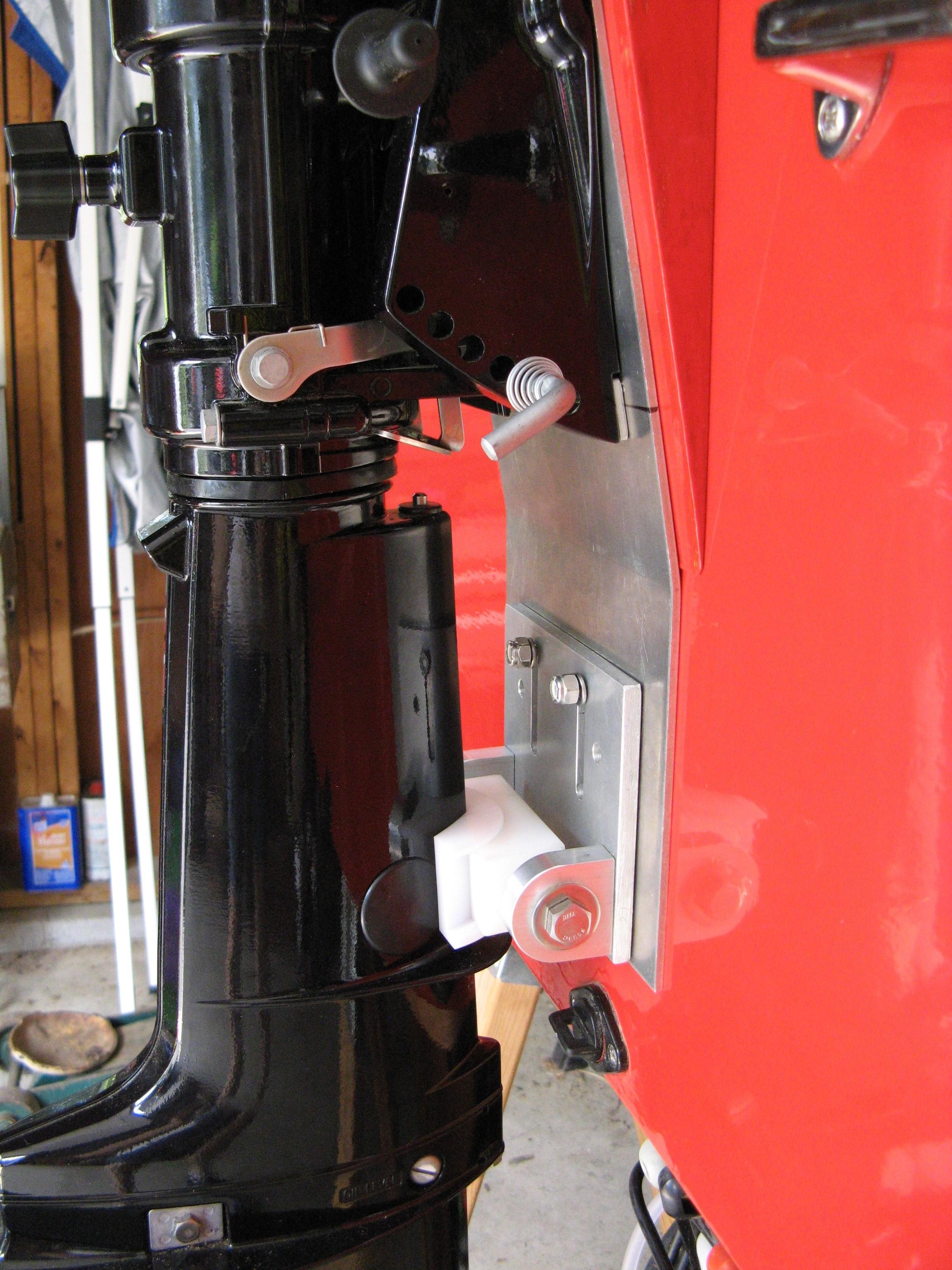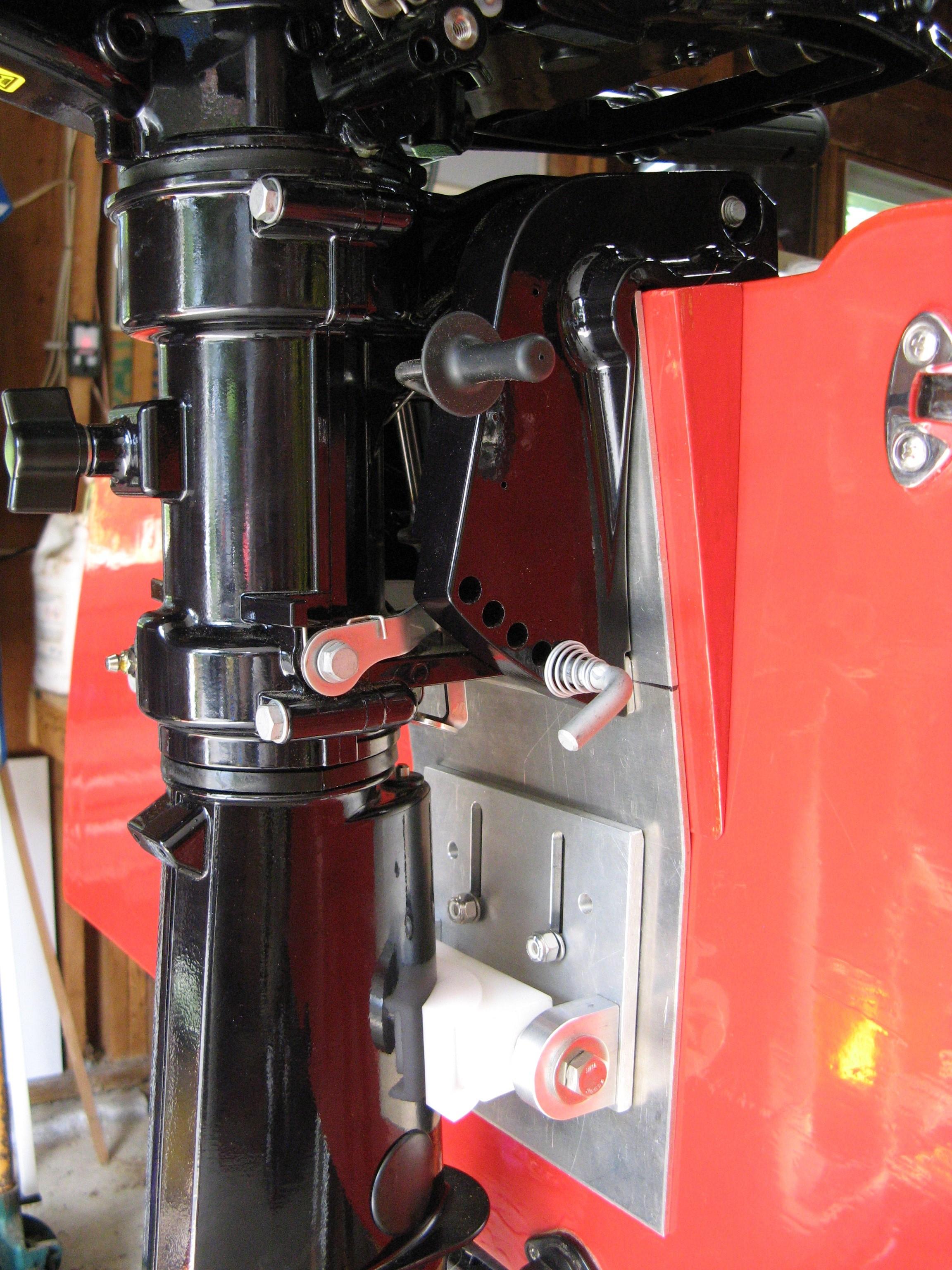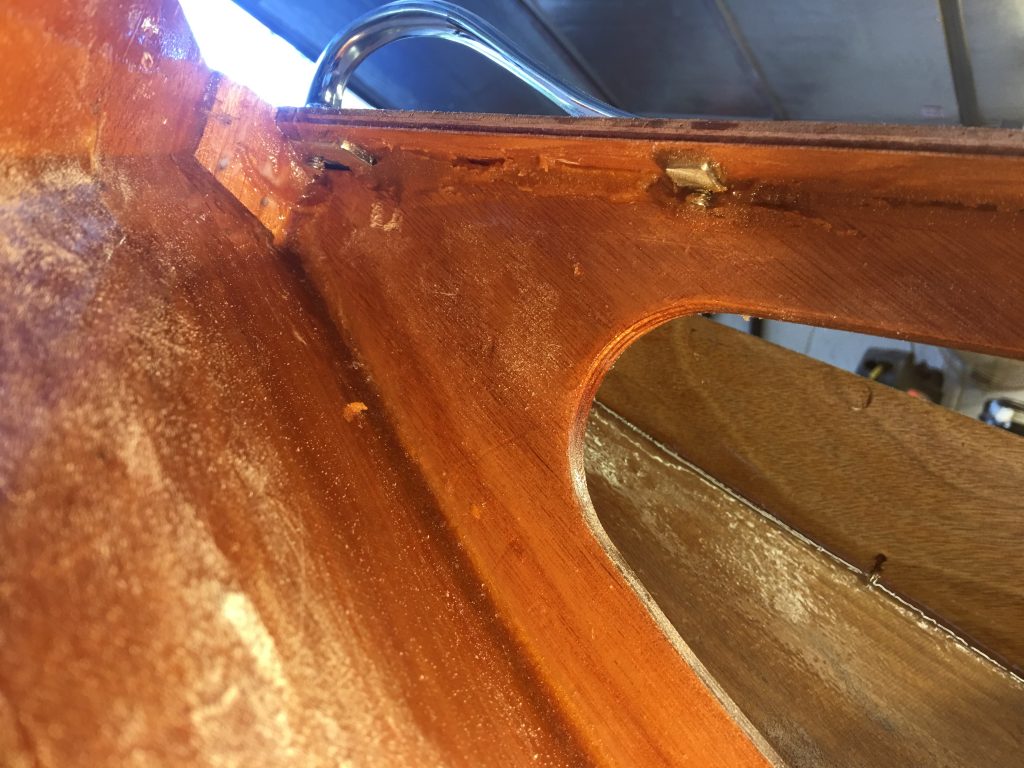Forum Replies Created
-
AuthorPosts
-
 RickKeymaster
RickKeymasterIf you are referring to the transom mount brackets on the inside of the transom, the screw handles of the transom clamps on the OMC engines have a center measurement of 5 1/4″ centers with a 1 1/4″ dia. pad and the Tohatsu measures 4.5″ centers with a 1 1/2″ dia. pad.
The OMC has two tabs for bolts to mount through the transom at 7 1/8″ centers on the outside of the transom. The Tohatsu does not come with through bolts, nor does it have a tab to connect a safety cable. I removed the small aluminum plate on the tohatsu and replaced it with a larger one with the same interchangable pattern for either motor with 7 1/8″ center holes.
Rick
 RickKeymaster
RickKeymasterYes, it does, and that is good. When using an 8HP motor the racing rules require the wedge and transom to be drilled and bolted with the stock holes on the 8HP OMC motors. This allows me to use the same bolts with the Tohatsu. The bolts should then have a wedge washer on the transom so the bolts seat flat on the transom.

 RickKeymaster
RickKeymasterAndy, there should not be a gap between the nose block and the deck. I don’t have the build manual handy right now and it is difficult to tell from this photo what the problem is. The king plank should rest on the center frame and end at the nose block. It is not clear, but you might have trimmed down the nose block too far along with the toe railings. There should not be a gap between the deck and toe railings. Could you post more pictures?
 RickKeymaster
RickKeymasterThe Tohatsu uses the same wiring configuration as the OMC engines. There is a wiring harness that can be purchased to link to the Tohatsu kill switch on the remote control, but I connected to the two wires on the engine where the harness would have connected with my OMC kill switch wires.
 RickKeymaster
RickKeymaster RickKeymaster
RickKeymasterMissed one!

 RickKeymaster
RickKeymasterMarty Calon’s Tohatsu photos



 RickKeymaster
RickKeymasterMarty,
I can post the picture if you could send it to me, southeastregion@ccwbra.com.
Rick Loewen
Southeast Region Fleet Captain
July 13, 2021 at 6:05 pm in reply to: A few questions about backing, motor wedges, & Aluminum back plating #13063 RickKeymaster
RickKeymasterAndy,
I backed up my transom handles inside the side tank by epoxying a 3/4″ strip of wood behind the mounting points, similar to what Marty did. I would have preferred to drill and tap a piece of stainless steel as I did for my other mounting hardware points, but I was in a rush to get the deck on. I placed the handles centered 5″ below the point where the deck meets the carlins. The horizontal centerline of the handles is 5″ from the outisde of the hull sides. Those handle locations work perfectly.
The bow handle should definitely be backed well. I go for solid through-bolts on essential hardware, way more than I would trust wood screws. I often hang my boat in the garage to work on it and also like the assurance that I can tow anything or be towed without fear of pulling something off. I used threaded SS metal under the king plank for the bow handle and glued plates drilled for Uflex and classic shifter boxes. I can drill and tap new holes for any additional needs. I also added a vertical plywood strip for support behind the shifter.For pictures, details and a build blog, see teamloewen.com. I took a long rest after attaching the deck, but I plan to complete it soon.

Our boat has a vertical transom. Most power boats have an angled transom, so the OMC motor mount clamp is angled at about 10° from vertical (motor drive shaft). The wedge angle should be one that aligns the propeller shaft parallel with the bottom of the boat, but this angle should be fine tuned for optimum performance based on boat attitude, weight placement and much more.
I experimented with the motor wedge angle by making three (8 3/4″W x 6″H) wedges, 10°, 12° and 14°. The easiest way to measure the angles is to use two long aluminum rulers bolted together through the holes in the ends and measure with a protractor. Use one against the bottom and the other on the cavitation plate above the propeller. I setteled on 12° since it is the max and less can be adjusted on the motor bracket. The limiting factor is the width of the transom mount clamp (2 1/4″) on the motor, anything more that 12° won’t fit.
Another consideration is that when a wedge is added to the back of the transom, a wedge is needed on the front for theclamp screws and motor bolts to create a parallel surface. That distance limits us to a 12° wedge that has a thicknes of 2 1/4″ at the top. I modeled prototype clamp wedges from hardwood and then fabricated them from aluminum block material cut on my table saw with a carbide blade. You will also require wedges on the motor bolts on the transom inside. I can send pictures if you like.
Thrust brackets serve a different purpose than setting the prop shaft angle to the boat. A thrust bracket is used to reduce the stress to the top of the transom and provide support to the bottom of the motor so the transom does not flex. After several runs, I saw some contact of the motor against the transom. I plan to make a thrust bracket, but my temporary fix was to fabricate a small rectangular stainless steel plate for protection. It is 2″ x 4″ and has holes drilled to match the drain plug so the contact area slightly above the drain plug is covered.About the aluminum back plate, I added reinforcement blocks inside the tank where the cockpit sides meet the transom. I also added two vertical large triangular gussets on either side of the transom knee.
 RickKeymaster
RickKeymasterI recently purchased the Tohatsu and ordered all the parts on the list. I also have the Ultraflex box for my OMC motors, but I like the traditional single lever control that Tohatsu uses. I have found that someone that is not used to using separate shift and throttle levers has difficulty a little difficulty with dual controls.
If I had it to do over, I would not have spent the money on the cable harness and parts for the Tohatsu kill switch. I have a nice kill switch mounted in the cockpit and it was simple to wire in the same manner as the OMC motors.Rick
 RickKeymaster
RickKeymasterWow, TK. The ‘ole forum still works!
Great resources! Always looking for parts stashes, thought I had already got to the edge of the internet and almost fell off, mabye it isnt really flat!
Rick
 RickKeymaster
RickKeymasterI used a piece of sapele (same as used on toe rail, carlins, etc.) cut as a continuous gusset the vertical length of the transom knee. You could remove material from the fillet with a rasp and carbon paper for fit. I feel it gave me a very strong joint. The other area I had issues with was the fillet between the cockpit walls and the floor. I was guilty of maybe too much sanding and small fillets and had a fairly bad crack starting after some good “air time” fun. I made similiar strips to reinforce the floor to sidewalls for a good repair.
Here are some photos: https://teamloewen.com/CocktailClass/img_3305/
https://teamloewen.com/CocktailClass/wp-admin/upload.php?item=621
Digging those photos out reminds me how far I am behind on my build blog.
 RickKeymaster
RickKeymasterJust a FYI, the bow handle is from the AMF Sunfish sailboat, a small sailboat that has been around for many many years. Because they are made of zinc, they will not hold up as long as quality stainless steel, but they still do quite well. I’ve seen a lot of old ones, but never seen a broken one!
Rick
 RickKeymaster
RickKeymasterI would highly recommend following the manufacturer’s specs on your specific application. The forums and product ratings have lots of questions and answers about these issues, but it would be much safer to go to the manufacturer or distributors for the answers. This is something you don’t want to get wrong. Interlux Pre-Kote does specifically say not to use it below the waterline, so maybe it would be best to get their interpretation of use below the waterline. I saw a different product recommendation that said even overnight in the water is not recommended, but that was not Interlux.
Interlux is a popular product with some major distributors offering support, so I would make a call to a support technician to get an interpretation from Interlux for our specific application. And let us know what you find out.
Rick
 RickKeymaster
RickKeymasterI hope this isn’t too late, but here is some info from a friend that gave me his recipe for finishing epoxy. He used to race small hydroplane racers and has a lot of experience and good advice.
Epoxy- I use 120 grit between coats with orbital palm sander, needs to be dull all over for next coat in order for mechanical bond. Last coat before varnish I sand epoxy with 220 grit with orbital then hand sand with 360 wet with some dish soap in water. I use low to medium revs on the sander. Any swirls left in the epoxy will be visible later. If you get the coats on at the right time there can be a somewhat chemical bond, depends on temp and tack condition of epoxy, this approach certainly saves time and labor but the last coat needs to be sanded for varnish or paint.
I apply the epoxy with 3/16″ thick x 9″ long yellow foam roller by Wooster(Lowes SKU 71497 11626 might have got it a Home Depot you can check with SKU)and tip with a 4″ foam brush (Walmart) for large areas. These rollers fit standard roller handle they can be cut shorter and they make a 7″ roller to fit these roller tubes. They are not reusable, hard to get all epoxy out. They do make small foam rollers that fit on the small pin type handles. When all the epoxy is rolled on I do the applied area with a final roller to get as uniform as I can, then tip in one direction with the foam brush to knock the bubbles off.
BTW you can clean up un-cured still flow-able epoxy with white vinegar, cheap and non toxic to skin.
For varnish I sand between coats with 360 wet with some dish soap in water. 3 coats of varnish is all that is needed to protect epoxy unless you want more. I use Minwax Spar Varnish Clear Gloss oil base and roll it on with the same type roller as with the epoxy and tip it with a foam brush. When all the varnish is rolled on I do the applied area with a final roller to get as uniform as I can, then tip in one direction with the foam brush to knock the bubbles off. For small areas I just use the foam brush. Get the varnish on quick and uniform, that is the key no need to work up a lather. Always work the varnish from dry to the last wet edge. I always test the varnish for flow-out for the conditions of the day if it does not lay down in 5 minutes with a perfect gloss I add some paint thinner. When temps are above 85 to hot for varnish. I shoot for 75 in the am for best results.
If you want to buff the last coat of varnish let it dry for about a week or two then 3,000 wet sand with (Walmart automotive) 3M polish finishing pad. Add dish soap to water, wipe dry then hand sand with 5000 wet (might be hard to find) with dish soap. I then machine buff with a foam pad (about 1″ thick) with a variable speed Harbor Freight machine (low to medium rpm) using Turtle wax scratch and swirl remover about $3 at Walmart.
If you do not want to buff, then leave the last varnish coat alone and it is what it is.
I use alcohol to wipe down between coats of epoxy or varnish then a tack cloth.
Ask any questions about above, engine set up, etc. , keep me posted, nice boat and work. Looks like a fun ride.
Pete Sushinsky
Rick Loewen
Rumrunner SE Fleet Captain
It’s 5 O’ Clock Somewhere #500 -
AuthorPosts
